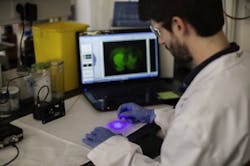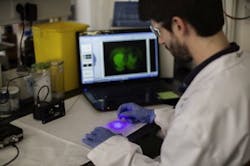Research team develops visible light-activatable drug to treat pain
Common pharmacology has important limitations, including slow and inexact distribution of the drug, lack of spatiotemporal traits in the organism, and difficulties in the dose adjustments, which can limit the therapeutic action of drugs. In this context, optopharmacology is an emerging discipline in pharmacology, based on the use of light to control drug activity. So, by using light on a photosensitive drug, the pharmacological process can be controlled with spatiotemporal precision.
Recognizing this, a team of researchers at the Institute of Neurosciences of the University of Barcelona (Spain) and colleagues has developed a light-activated drug for pain treatment. The drug, called JF-NP-26, has a light-activatable molecule that can be specifically activated with light via an optical fiber onto targeted tissue and, therefore, with high spatiotemporal resolution.
Compared to other photosensitive compounds, the JF-NP-26 molecule has no pharmacological effect until the targeted tissue receives light from the visible spectrum (405 nm). Moreover, according to the research team's studies on animal models, the drug does not show toxic or unwanted effects, even if the dose is high.
The drug's lightening includes a treatment on the molecule to release the active molecule (raseglurant) that blocks the metabotropic glutamate type 5 (mGlu5) receptor found in lots of neuronal functions, such as the spread of neuronal pain. This can be produced because of the outlying neurons and the central nervous system, and create, in both cases, an analgesic effect as a result.
"The molecule created by the action of the light, the raseglurant, does not belong to any group of drugs from the classic anti-pain list of drugs: non-steroidal anti-inflammatory drugs or NSAID (paracetamol, ibuprofen, etc.) and opioids (morphine, fentanyl). Consequently, this study describes an analgesic mechanism which has not been explored enough so far," explains Francisco Ciruela, a professor in the Faculty of Medicine and Health Sciences at the University of Barcelona. "Actually, the raseglurant was examined in clinical trials as an analgesic to treat migraine, but it was ruled out due to its hepatoxicity. This new optopharmacology of the raseglurant can stop adverse effects in the liver and opens a new path to start using it as an analgesic," he adds.
"If we compare natural biological molecules that act in living beings with drugs, we can see that the former can work with great precision, acting in centralized areas and with regulated doses, with defined lengths," says Amadeu Llebaria of the Medicinal Chemistry & Synthesis (MCS) group of the Institute of Advanced Chemistry of Catalonia (IQAC-CSIC), a collaborator involved in the work. "However, the drugs we have act in all areas and without a strict control. The use of light-controlled molecules tries to complete these spaces to get more precise drugs that can act like biological molecules."
The MCS group is now participating in several projects on photo-pharmacology, working on the design and synthesis of several light-activated molecules. "This approach is more complex than the one on a conventional drug since, apart from the therapeutic features, the molecule's photochemical and photophysical responses have to be prioritized," Llebaria says.
Addtional colleagues from the Institute of Neurosciences at the University of Barcelona, along with the Bellvitge Biomedical Research Institute (IDIBELL), are working on research lines in optopharmacology to respond to problems related to conventional pharmacology. "At this moment, we are examining other molecules with different action mechanisms, but also based on G protein-coupled membrane receptors—the biggest therapeutic target at the moment," Ciruela explains. "Therefore, we have drugs under study for the treatment of Parkinson's disease or psoriasis. We are also exploring the optopharmacological use of light with different wavelengths (green, yellow, and red), which are even less toxic. Regarding the future, we cannot rule out some symptomatology to be lowered with optical fibers in the brain, just like electrodes are put in deep brain stimulation with Parkinson’s disease."
Other participants in the study include researchers from the Institut Química de Sarrià (Sarrià Chemical Institute; IQS), the Universitat Autònoma de Barcelona (UAB), the Institute for Functional Genomics (IGF) from the University of Montpellier (France), and the Sapienza University of Rome and Neuromed Institute (Italy).
Full details of the work appear in the journal eLife; for more information, please visit http://dx.doi.org/10.7554/elife.23545.

